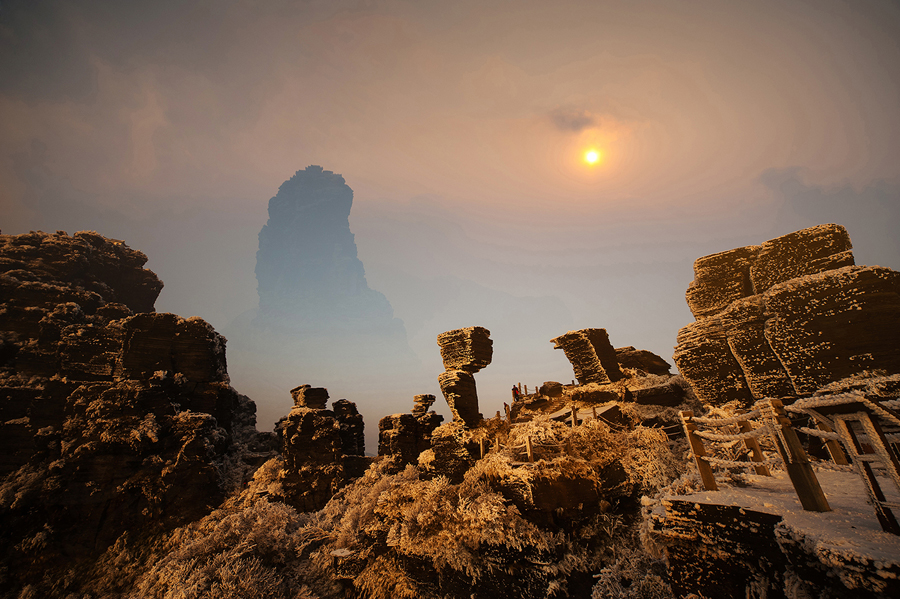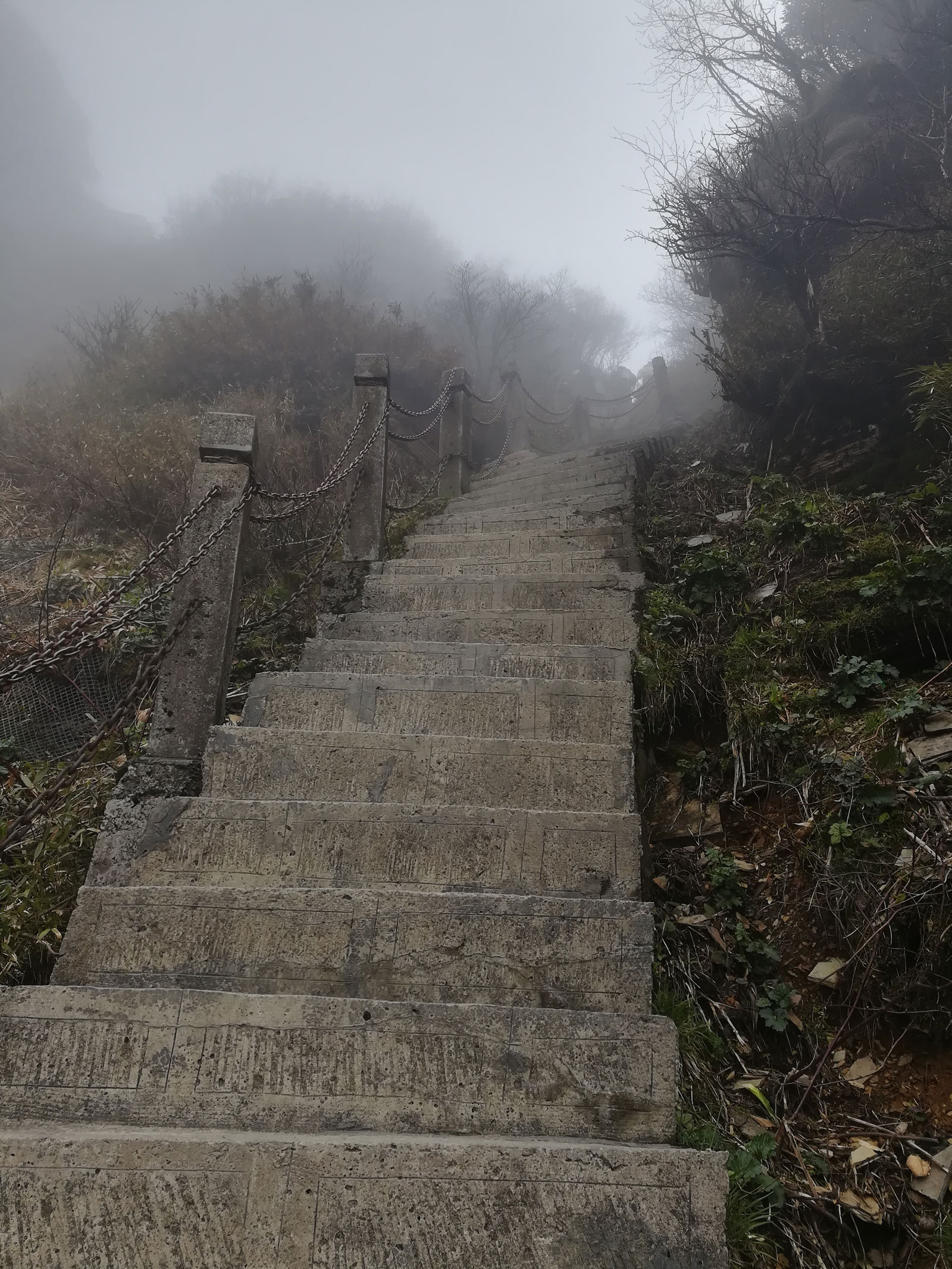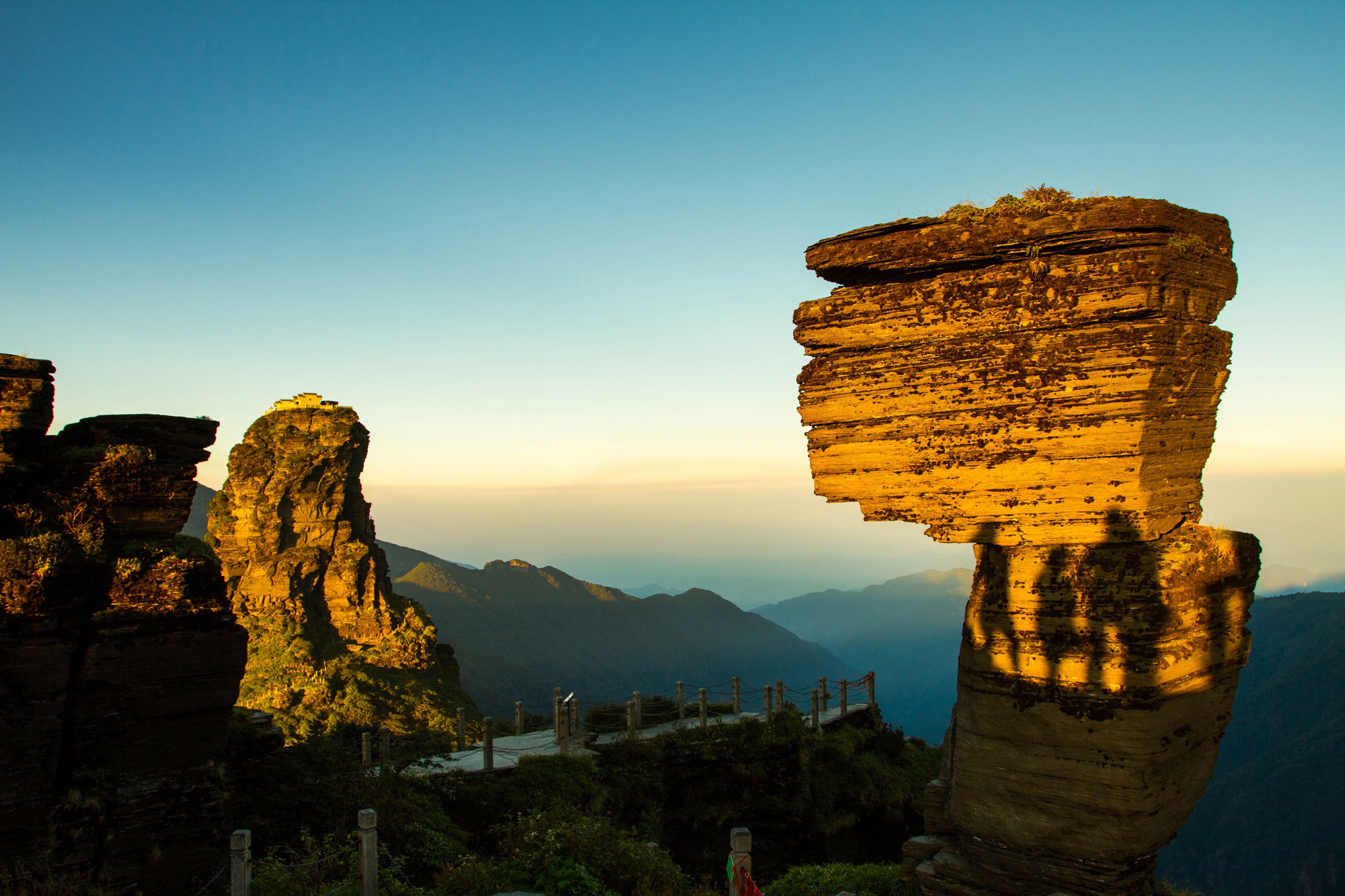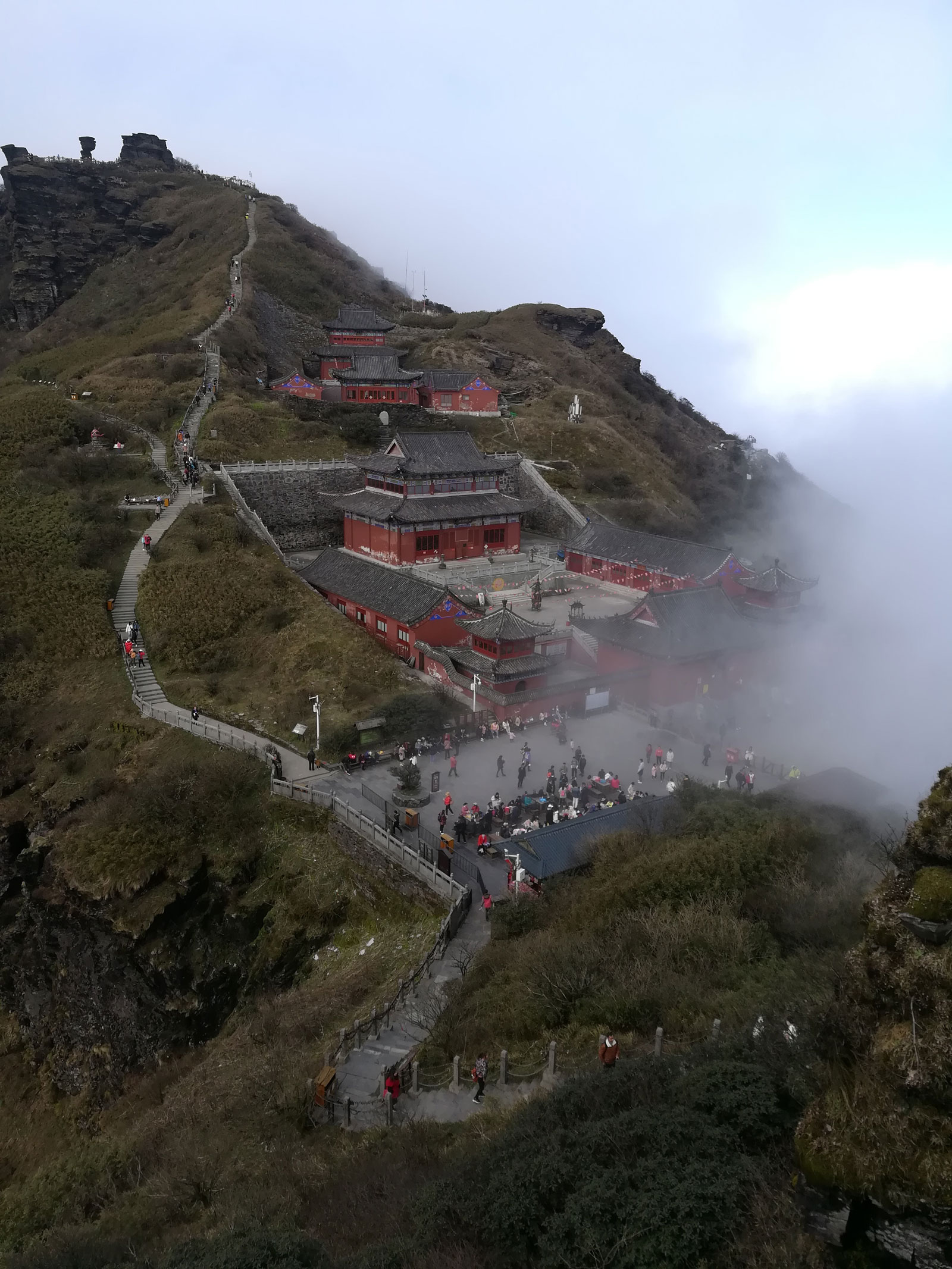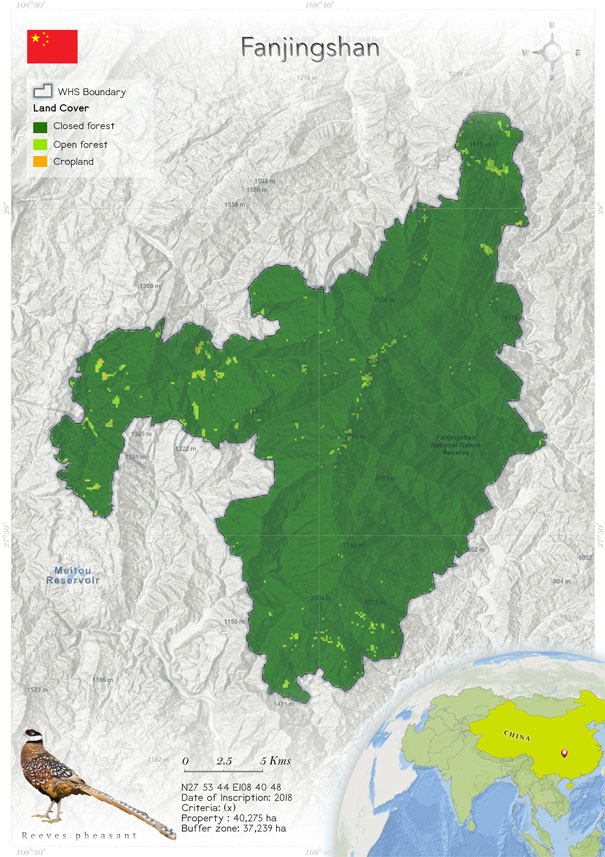
Fanjingshan (1559)
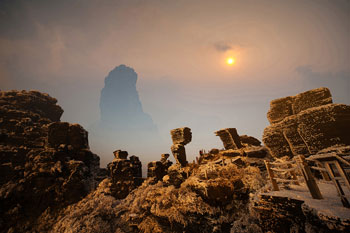 The Fanjingshan World Heritage Site is located in south-western China with an extent of 40,275 ha and a buffer zone with an extent of 37,239 ha. It has a monsoonal climate, which feeds 20 rivers and streams of the Wujiang and Yunjiang river systems, draining into the Yangtze River. The Jian Nan sub-tropical evergreen forests cover 64% of the eco-region, and the rest is covered by the Guizhou Plateau broadleaf and mixed forests. Fanjingshan is characterized by its highest peak, Mount Fenghuangshan, which has an elevation of 2570 m above sea level (masl). The property is situated above 2000 m. The distribution of the plant species is determined by the geologic and climatic conditions. There is a very high degree of endemism: 46 plant species are endemic to the property (including the endangered Fanjingshan fir, Abies fanjingshanensis), four endemic vertebrate species (including the endangered Guizhou snub-nosed monkey, Rhinopithecus brelichi) and 245 invertebrate species . Fagus species (F. longipetiolata, F. lucida and F. engleriana) are dominant, constituting the largest primary beech forest in the sub-tropical region. The current threats to the site are linked with the high levels of tourism, which may potentially cross the safety levels defined by the IUCN and cable car construction. The protection and management efforts closely monitor the numbers of visitors, who stay mostly within the permitted areas (2.1% of the site). The potential threats include climate change, which threatens the survival of species such as the Guizhou snub-nosed monkey, which is endemic to the site.
The Fanjingshan World Heritage Site is located in south-western China with an extent of 40,275 ha and a buffer zone with an extent of 37,239 ha. It has a monsoonal climate, which feeds 20 rivers and streams of the Wujiang and Yunjiang river systems, draining into the Yangtze River. The Jian Nan sub-tropical evergreen forests cover 64% of the eco-region, and the rest is covered by the Guizhou Plateau broadleaf and mixed forests. Fanjingshan is characterized by its highest peak, Mount Fenghuangshan, which has an elevation of 2570 m above sea level (masl). The property is situated above 2000 m. The distribution of the plant species is determined by the geologic and climatic conditions. There is a very high degree of endemism: 46 plant species are endemic to the property (including the endangered Fanjingshan fir, Abies fanjingshanensis), four endemic vertebrate species (including the endangered Guizhou snub-nosed monkey, Rhinopithecus brelichi) and 245 invertebrate species . Fagus species (F. longipetiolata, F. lucida and F. engleriana) are dominant, constituting the largest primary beech forest in the sub-tropical region. The current threats to the site are linked with the high levels of tourism, which may potentially cross the safety levels defined by the IUCN and cable car construction. The protection and management efforts closely monitor the numbers of visitors, who stay mostly within the permitted areas (2.1% of the site). The potential threats include climate change, which threatens the survival of species such as the Guizhou snub-nosed monkey, which is endemic to the site.
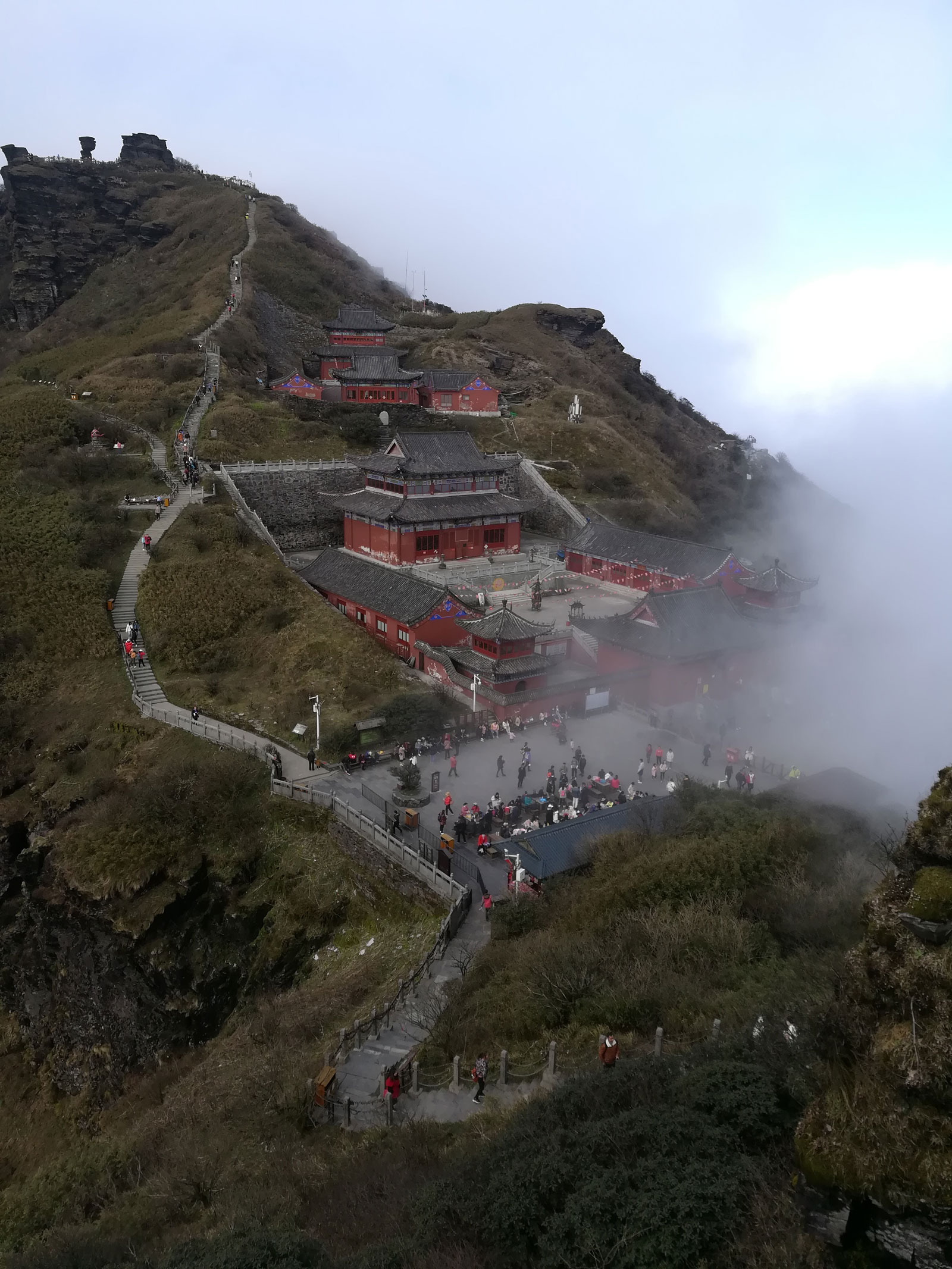 The Fanjingshan World Heritage Site is located at south-western China having an extent of 40,275 ha with a buffer zone of extent 37,239 ha. The climatic conditions are classified as a monsoonal climatic environment that is crucial for water sources, spawning 20 rivers and streams that eventually flow into the Yangtze River. The site is covered with a variety of forest types, including the Jian Nan subtropical evergreen forests, which cover 64% of the ecoregion, and the Guizhou Plateau broadleaf and mixed forests, which cover 36% of the ecoregion. Fanjingshan is distinguished by Mt Fenghuangshan's tallest summit, which rises 2,570 metres above sea level (masl), and the property is located at a height of more than 2,000 metres. The property is distinguished by vertical stratification of the vegetation, with three distinct elevations: evergreen broadleaf forest (less than 1300 masl), mixed evergreen and deciduous broadleaf forest (1300–2200 masl) and mixed evergreen deciduous broadleaf and conifer and scrub forest (>2200 masl). One of the prominent features of the site includes the presence of an island of metamorphic rock in a sea of karst, which hosts the ancient flora and fauna. Its origin is in the Tertiary period, between 65 million and 2 million years ago.
The distribution of the plant species is determined by the geologic and climatic conditions and greater emphasis laid on the presence of very high degree of endemism with 46 locally endemic plant species, 4 endemic vertebrate species coupled with 245 invertebrate species that included Fanjingshan Fir (Abies fanjingshanensis – EN) and Guizhou Snub-nosed Monkey (Rhinopithecus brelichi – EN) with entirely restricted within the property. The pertinent species of Fagus present in large number is (F. longipetiolata, F. lucida, and F. engleriana) constituting the biggest primary beech forest in the sub-tropical region. There is an extremely high diversity of invertebrates (2317 species). The property has 450 vertebrates. It is the only place in the world in which the Fanjingshan fir and Guizhou snubnosed monkey are present. Sixty-four plant species and 38 animal species found in Fanjinghsan are threatened, including the tree Bretschneidera sinensis (EN), Chinese giant salamander (Andrias davidianus – CR), forest musk deer (Moschus berezovskii – EN), Reeves’s pheasant (Syrmaticus reevesii – VU) and Asiatic black bear (Ursus thibetanus – VU). For facilitating better protection and management, the site is divided into Fanjingshan National Nature Reserve, Yinjiang Yangxi Provincial Nature Reserve and National Non-commercial Forest. There is a clear demarcation of the boundaries and the buffer zone considering floristic elements of large size to include the home ranges of threatened species. The site is also a UNESCO Biosphere Reserve, and it is crucial to demarcate the boundaries of the property with its buffer zone for effective protection and management (UNESCO whc.unesco.org).
The Fanjingshan World Heritage Site is located at south-western China having an extent of 40,275 ha with a buffer zone of extent 37,239 ha. The climatic conditions are classified as a monsoonal climatic environment that is crucial for water sources, spawning 20 rivers and streams that eventually flow into the Yangtze River. The site is covered with a variety of forest types, including the Jian Nan subtropical evergreen forests, which cover 64% of the ecoregion, and the Guizhou Plateau broadleaf and mixed forests, which cover 36% of the ecoregion. Fanjingshan is distinguished by Mt Fenghuangshan's tallest summit, which rises 2,570 metres above sea level (masl), and the property is located at a height of more than 2,000 metres. The property is distinguished by vertical stratification of the vegetation, with three distinct elevations: evergreen broadleaf forest (less than 1300 masl), mixed evergreen and deciduous broadleaf forest (1300–2200 masl) and mixed evergreen deciduous broadleaf and conifer and scrub forest (>2200 masl). One of the prominent features of the site includes the presence of an island of metamorphic rock in a sea of karst, which hosts the ancient flora and fauna. Its origin is in the Tertiary period, between 65 million and 2 million years ago.
The distribution of the plant species is determined by the geologic and climatic conditions and greater emphasis laid on the presence of very high degree of endemism with 46 locally endemic plant species, 4 endemic vertebrate species coupled with 245 invertebrate species that included Fanjingshan Fir (Abies fanjingshanensis – EN) and Guizhou Snub-nosed Monkey (Rhinopithecus brelichi – EN) with entirely restricted within the property. The pertinent species of Fagus present in large number is (F. longipetiolata, F. lucida, and F. engleriana) constituting the biggest primary beech forest in the sub-tropical region. There is an extremely high diversity of invertebrates (2317 species). The property has 450 vertebrates. It is the only place in the world in which the Fanjingshan fir and Guizhou snubnosed monkey are present. Sixty-four plant species and 38 animal species found in Fanjinghsan are threatened, including the tree Bretschneidera sinensis (EN), Chinese giant salamander (Andrias davidianus – CR), forest musk deer (Moschus berezovskii – EN), Reeves’s pheasant (Syrmaticus reevesii – VU) and Asiatic black bear (Ursus thibetanus – VU). For facilitating better protection and management, the site is divided into Fanjingshan National Nature Reserve, Yinjiang Yangxi Provincial Nature Reserve and National Non-commercial Forest. There is a clear demarcation of the boundaries and the buffer zone considering floristic elements of large size to include the home ranges of threatened species. The site is also a UNESCO Biosphere Reserve, and it is crucial to demarcate the boundaries of the property with its buffer zone for effective protection and management (UNESCO whc.unesco.org).
Criterion (viii)
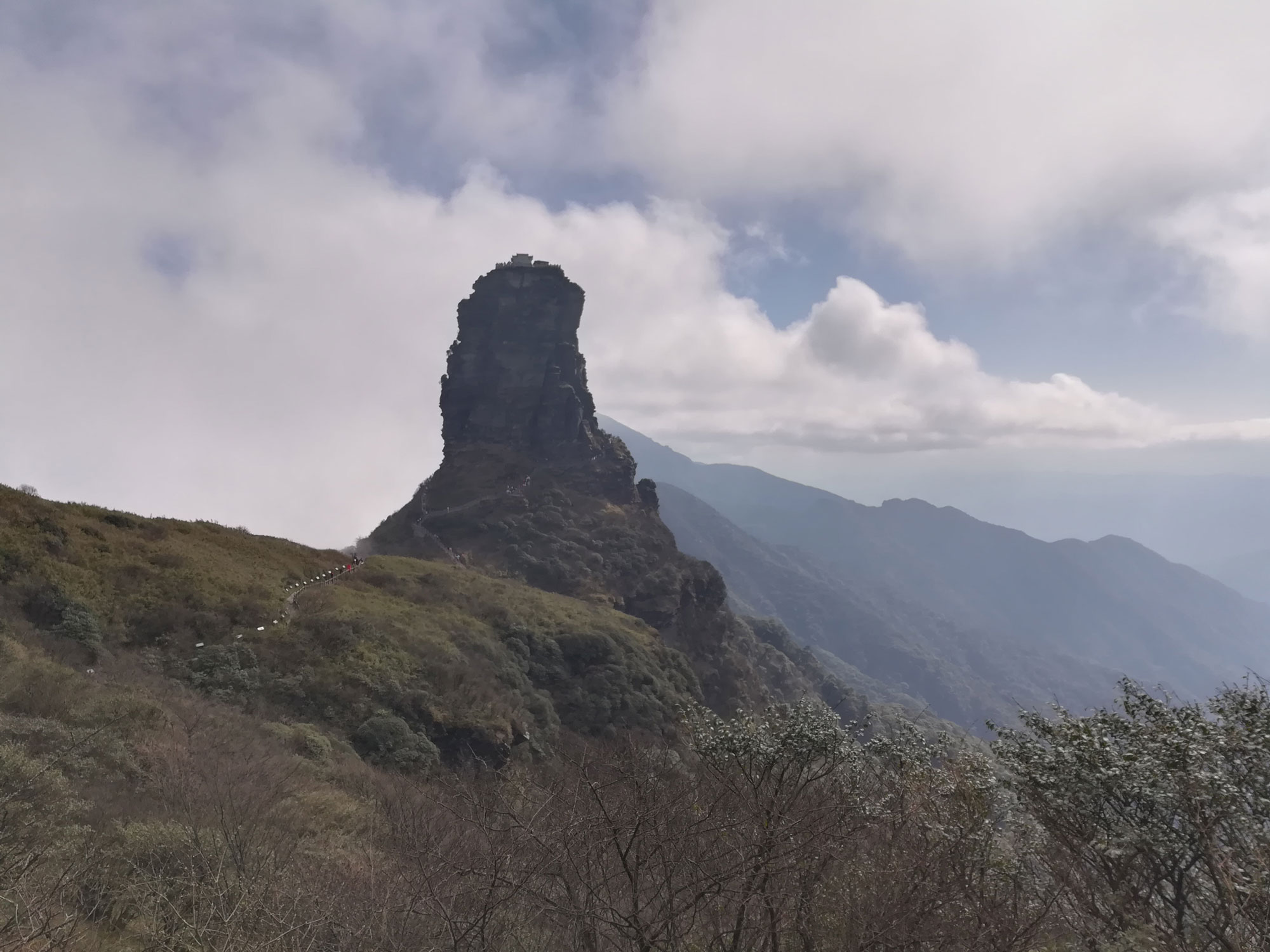 Fanjingshan is characterized by an exceptional richness in bryophytes, with 791 species, of which 74 are endemic to China. The property also has one of the richest concentrations of gymnosperms in the world, with 36 species. A significant number of endemic species are distributed inside the property, including 46 local endemic and 1,010 Chinese endemic plant species, as well as 4 locally endemic vertebrate species. The most notable of these is the endangered Guizhou Snub-nosed Monkey, which is found only in Fanjingshan and nowhere else in the world. Another prominent endemic species is Fanjingshan Fir, which is also restricted to this property. The property contains 64 plant and 38 animal species that are listed as Vulnerable (VU), Endangered (EN) or Critically Endangered (CR) on the IUCN Red List, most notably Guizhou Snub-nosed Monkey, Chinese Giant Salamander, Forest Musk Deer, Reeves’s Pheasant, Asiatic Black Bear, and Bretschneidera sinensis.
The property contains 64 plant and 38 animal species that are listed as Vulnerable (VU), Endangered (EN) or Critically Endangered (CR) on the IUCN Red List, most notably Guizhou Snub-nosed Monkey, Chinese Giant Salamander, Forest Musk Deer, Reeves’s Pheasant, Asiatic Black Bear, and Bretschneidera sinensis
Fanjingshan is characterized by an exceptional richness in bryophytes, with 791 species, of which 74 are endemic to China. The property also has one of the richest concentrations of gymnosperms in the world, with 36 species. A significant number of endemic species are distributed inside the property, including 46 local endemic and 1,010 Chinese endemic plant species, as well as 4 locally endemic vertebrate species. The most notable of these is the endangered Guizhou Snub-nosed Monkey, which is found only in Fanjingshan and nowhere else in the world. Another prominent endemic species is Fanjingshan Fir, which is also restricted to this property. The property contains 64 plant and 38 animal species that are listed as Vulnerable (VU), Endangered (EN) or Critically Endangered (CR) on the IUCN Red List, most notably Guizhou Snub-nosed Monkey, Chinese Giant Salamander, Forest Musk Deer, Reeves’s Pheasant, Asiatic Black Bear, and Bretschneidera sinensis.
The property contains 64 plant and 38 animal species that are listed as Vulnerable (VU), Endangered (EN) or Critically Endangered (CR) on the IUCN Red List, most notably Guizhou Snub-nosed Monkey, Chinese Giant Salamander, Forest Musk Deer, Reeves’s Pheasant, Asiatic Black Bear, and Bretschneidera sinensis
Status

